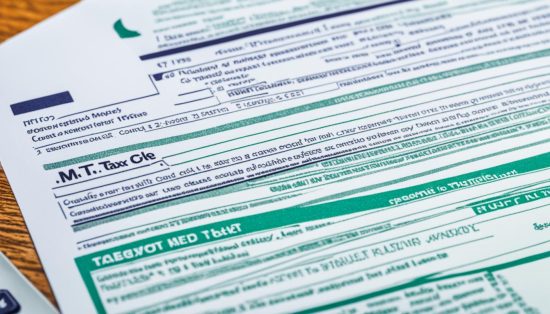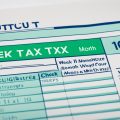Last Updated on: 18th April 2024, 10:57 am
Welcome to our guide on Tax Code M in the UK! If you want to maximize your savings and ensure you’re making the most of your tax code, you’ve come to the right place. In this article, we’ll walk you through everything you need to know about tax code maintenance, updates, and HMRC tax code guidance. Understanding these key aspects will help you navigate the complexities of the tax system and make informed decisions about your finances.
So, let’s dive in and discover how Tax Code M can impact your savings and provide valuable opportunities for financial success.
What Is Tax Code M and How Does It Work?
Tax Code M is a combination of numbers and letters used by employers to calculate the amount of tax to deduct from an employee’s pay. It indicates the tax-free earnings an employee is entitled to in a specific pay period. The tax-free amount is determined by HMRC based on the individual’s circumstances and can be adjusted throughout the year to ensure compliance with tax regulations.
Understanding how this tax code works is essential to ensure accurate tax deductions and compliance with HMRC guidelines.
Understanding Tax Code M
Tax Code M is an important component of the UK tax system. It helps employers determine the amount of tax to deduct from their employees’ pay. The tax code consists of a letter, which represents different tax scenarios, and a number.
The letter indicates the individual’s personal circumstances, such as being entitled to the standard personal allowance or having a specific tax situation. The number further refines the tax code, taking into account factors like savings income and other adjustments.
How Tax Code M Works?
The tax-free earnings indicated by Tax Code M are applied within a specific pay period, typically a month or week. Employers use this tax code to calculate the amount of income that an employee can earn before income tax is applied.
For example, if an employee has a tax code of M1100L, the number 1100 represents the amount of tax-free earnings in pounds. The letter L signifies that the individual is entitled to the standard tax allowance.
The tax code M can be adjusted throughout the year to accommodate changes in an individual’s circumstances. These adjustments ensure compliance with updated tax regulations and help individuals avoid overpaying or underpaying taxes.
When there are changes in factors like income, savings, or tax allowances, it’s important for employees to provide updated information to their employers so that the tax code M can be adjusted accordingly.
The Importance of Understanding Tax Code M
Understanding how Tax Code M works is essential for accurate tax deductions and compliance with HMRC regulations. It allows individuals to ensure that the correct amount of tax is deducted from their pay and helps prevent overpayment or underpayment of taxes.
Failing to understand your tax code M or provide updated information to your employer can result in inaccurate deductions and potential tax liabilities. It is important to review your tax code regularly, especially if there are changes to your income or personal circumstances.
By familiarizing yourself with the tax code M and its workings, you can take control of your tax affairs and make informed financial decisions.

Tax Code M and Personal Allowance
The tax code M is closely tied to the personal allowance, which is the amount of income an individual can earn before they start paying tax. The personal allowance varies each tax year and can directly affect the tax code M. Staying updated with the current personal allowance is crucial as it has a direct impact on your tax liability and potential savings.
Understanding the relationship between tax code M and personal allowance:
When you start a new job or have changes in your circumstances, your employer or pension provider will allocate a tax code to ensure the correct amount of tax is deducted from your earnings or pension. Tax code M is specifically used to indicate that you are entitled to the standard personal allowance.
The personal allowance is the amount you can earn before you need to pay tax, and it varies based on factors such as your age, income level, and eligibility for any additional allowances or reliefs. It is typically reviewed and adjusted by the government annually.
For the tax year 2021/2022, the personal allowance in the UK is £12,570. This means that you can earn up to £12,570 in a tax year before you start paying tax. If your income exceeds the personal allowance, your tax code M will be adjusted accordingly to reflect the taxes you owe.
Here is an example to illustrate how tax code M and personal allowance work:
| Tax Year | Personal Allowance | Example Income |
|---|---|---|
| 2020/2021 | £12,500 | £20,000 |
| 2021/2022 | £12,570 | £20,000 |
In the example above, for the tax year 2020/2021, if you earned £20,000, your tax code M would reflect that you have exceeded the personal allowance by £7,500 (£20,000 – £12,500). Therefore, you would pay tax on the amount above the personal allowance.
However, for the tax year 2021/2022, with an increased personal allowance of £12,570, the taxable amount would be reduced to £7,430 (£20,000 – £12,570). This demonstrates how the personal allowance affects your tax liability and why it’s important to stay updated with the current personal allowance.

The Benefits of Staying Updated with Personal Allowance
- Maximizing your tax-free earnings: Stay within the personal allowance to keep more of your income.
- Reducing your tax liability: By utilizing the personal allowance effectively, you can minimize the amount of tax you owe.
- Planning your finances: Understanding your personal allowance helps you budget and make informed financial decisions.
- Claiming tax refunds: If your tax code M indicates that you’ve overpaid taxes due to a change in personal allowance, you may be eligible for a tax refund.
By staying informed about the personal allowance and how it directly affects your tax code M, you can optimize your tax position and potentially increase your savings or disposable income.
Updates and Adjustments to Tax Code M
Tax code M is not set in stone and can undergo updates and adjustments throughout the year. These changes can occur due to shifts in tax regulations or modifications to an individual’s circumstances. To ensure accurate tax deductions and compliance with HMRC guidelines, it’s essential to stay informed about potential updates to your tax code M. By understanding the meaning and implications of your tax code M, you can effectively manage your finances and make informed decisions.
Being aware of tax code changes is crucial as it allows you to adapt and plan accordingly. Whether it’s new laws or amendments to existing regulations, staying up to date ensures that you remain in compliance with the latest guidelines. This knowledge empowers you to make informed choices when it comes to your financial affairs and tax obligations.
By keeping track of HMRC tax codes and any modifications to tax code M, you can optimize your tax planning strategies. Understanding the changes and their impact will positively contribute to your overall financial management. It also prevents you from missing out on potential opportunities for tax relief or savings.
When it comes to understanding tax code M, consulting resources such as HMRC’s official website and guidance is vital. These resources provide comprehensive information and explanations, ensuring you have the most accurate knowledge at your disposal. Additionally, utilizing the HMRC tax code checker can help you verify the accuracy of your tax code M and ensure that you are in line with the regulations set by HMRC.

Adapting to Tax Code Modifications
Adjustments to your tax code M can have significant ramifications on your financial situation. When there are changes to the tax code, it is crucial to review and understand how these modifications affect your tax liabilities, benefits, and potential savings. Consulting with a tax professional or financial advisor can provide further guidance and clarity on navigating these changes effectively.
Being proactive and informed about updates to your tax code M allows you to make any necessary adjustments to your financial plans. Whether it’s reallocating funds, making changes to investments, or exploring additional tax relief measures, staying on top of tax code changes ensures that you are maximizing your financial potential.
Remember, tax code M is a dynamic element of the UK tax system. By staying informed and adaptable, you can navigate the ever-changing landscape and optimize your financial outcomes.
Tax Code M and Savings Interest
Earning interest on your savings is a great way to grow your wealth, but it’s important to consider the impact of your tax code M. Your tax code directly affects the amount of tax you need to pay on your savings interest. Understanding how your tax code M influences your tax liability can help you maximize your savings and potentially claim tax refunds or credits.
If your savings interest falls below the tax-free allowances, you may be eligible for a tax refund or credits, reducing your overall tax liability. To determine whether you are entitled to any tax benefits, it’s beneficial to utilize tax refund calculators and familiarize yourself with the relevant tax forms and rebate options associated with your tax code M.
By taking advantage of tax forms and rebates, you can make the most of your tax code M and maximize your savings potential. It’s essential to understand the intricacies of your tax code M, ensuring you’re compliant with HMRC guidelines and making informed decisions regarding your savings interest.
Example Tax Refund Calculation for Tax Code M
Suppose you have an annual savings interest of £1,500 and your tax code M provides a tax-free allowance of £2,000 for savings interest. As your savings interest is below the tax-free threshold, you won’t owe any tax on your interest earnings.
However, if your savings interest exceeds the tax-free threshold, you may owe tax on the portion that exceeds the allowance. Utilizing a tax refund calculator can help you understand the exact amount of tax you owe and determine whether you’re eligible for any refunds or credits.
| Savings Interest | Tax-Free Allowance | Taxable Amount | Tax Rate | Tax Owed |
|---|---|---|---|---|
| £1,500 | £2,000 | £0 | 0% | £0 |
In our example, as the savings interest is below the tax-free allowance, the taxable amount is £0, resulting in no tax owed. However, this may vary based on your specific circumstances, so it’s important to utilize tools like tax refund calculators to ensure accuracy.
Understanding the implications of your tax code M and its relationship with your savings interest is critical to make informed financial decisions. By staying informed about potential tax refunds, utilizing tax calculators, and being aware of the relevant tax forms and rebates, you can effectively maximize your savings and minimize your tax liability.
HMRC Tax Code Guidance and Compliance
When it comes to managing your tax affairs, it is essential to refer to HMRC’s official guidance. HMRC provides comprehensive guidelines and resources to help individuals understand their tax codes, including tax code M. By following HMRC’s guidance, you can ensure compliance and accuracy in your tax calculations.
To verify the accuracy of your tax code M and make sure you are on the right track for tax savings, utilize the tax code checker provided by HMRC. This online tool allows you to input your tax code and personal details to confirm its validity. It is a convenient way to double-check your tax code and ensure that you are receiving the correct allowances and benefits.
By referring to HMRC’s tax code guidance and utilizing the tax code checker, you can have peace of mind knowing that you are following the correct procedures and maximizing your savings. Stay informed, stay compliant, and stay on top of your tax code M with HMRC’s guidance and tools.

Conclusion
Understanding tax code M and its implications is crucial for maximizing your savings and minimizing your tax liability in the UK. By staying informed about tax code updates and following HMRC tax code guidance, you can navigate the complexities of the tax system and make the most of your tax code M. It is important to prioritize tax code maintenance and compliance to ensure financial success.




















No Comments
Leave a comment Cancel